Valve for a gas pipe in an apartment: features of selection, installation and maintenance standards
Regular gas explosions in apartments cause concern for owners, residents and utility services.Installing a leak control system partially solves this problem: it helps prevent fire, explosion, and poisoning. The design, in addition to the alarm, must include a valve on the gas pipe, which shuts off the fuel supply if dangerous situations arise.
In this publication, we will get acquainted with the requirements of gas services for integrating such a device into the main line. Let's find out what types of valves can be connected to gas alarms and what standards they must comply with. Plus, we’ll understand the nuances of installing the device on a pipe.
The content of the article:
Building rules and regulations
According to SP 60.13330.2016 furnishing of living quarters gas sensors is not mandatory and is carried out at the request of the customer. But this applies only to already constructed buildings.
In accordance with clause 6.5.7 SP 60.13330.2016 a gas alarm is required in new, reconstructed, or subject to major overhaul residential buildings where the operation of boilers, water heaters, stoves and other equipment is expected.
The actuator of such a sensor is a high-speed solenoid valve - a cut-off valve that blocks the gas supply. It should be installed at the gas inlet into the room and interlocked with the alarm device so that when the latter gives a signal, the valve immediately stops supplying blue fuel.
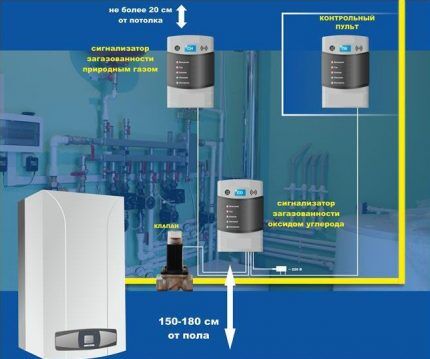
At the planning stage, the premises are surveyed. Areas in which gas may accumulate (depressions, niches) deserve close attention. The presence of “dead zones” should not be allowed.
In addition to reworking the internal wiring, if necessary, they disassemble, assemble or replace kitchen furniture, appliances, as well as installation:
- hidden electrical wiring;
- alarm information systems;
- forced ventilation.
All work is carried out according to the project, which requires preparatory actions. First you need to contact your local gas service.
The approval instructions look like this:
- Drawing up an application according to the sample indicating the desired changes in the highway. The document serves as the basis for a visit by a specialist to the place where the equipment is installed.
- Already on site, a representative of the organization inspects everything, checks it, makes calculations in accordance with the standards, taking into account the applicant’s plan.
- An estimate is calculated and a plan is prepared.
- The plan and estimate are agreed upon: the document is handed over to the applicant for review and consent to installation.
- Carrying out payment in case of agreement with the proposed project.
If the estimate and/or plan does not suit the customer, this is discussed with the foreman, a compromise solution is found and the project is finalized.
Choosing equipment for an apartment
All elements of the system must be equipped with permits, a Russian passport, a certificate and/or a declaration of conformity with the technical regulations of the Customs Union, which allow their use on the territory of the Russian Federation.
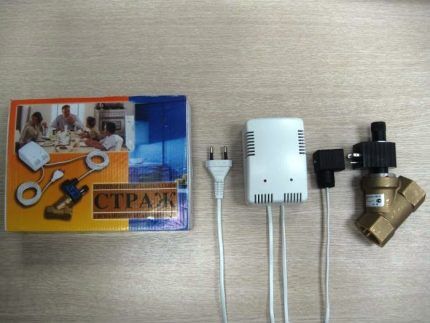
Purchasing a special set is preferable to purchasing devices separately. In the first case, the elements of the kit are already coordinated with each other in terms of parameters, adapted for work in domestic conditions, and supplied with operating instructions.
There are models of domestic and imported production on the market. Replacing and repairing the former is cheaper and easier to do.
If you select equipment separately, please note that there are sensor models that are not designed to connect a solenoid valve. They signal a leak and are able to inform the owner about the danger by sending SMS to the phone, but they do not shut off the gas.
Installing one sensor without a valve is inexpensive, you can install it yourself, but the reliability of protection from such a design is questionable. And such a system will not comply with the current rules.
Types of solenoid shut-off valves
Two types of cut-off valves are connected to the sensor: open (NO) and closed (NC). The former block the fuel supply only after the alarm in the system is triggered. The latter also react when there is a power outage.
You can return the valve to its original position after operation either manually or automatically. In apartments, manually cocked valves are mostly installed on the gas pipe; they are simpler and cheaper.
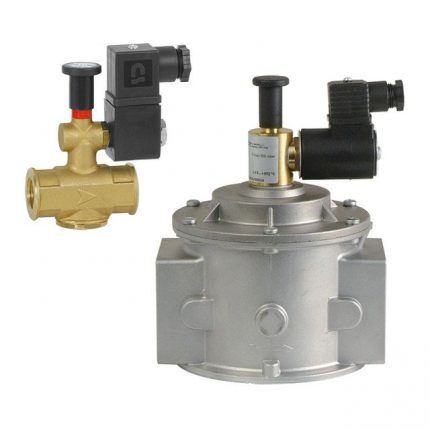
Normally open manual shut-off switches allow the equipment to operate as long as there is no supply voltage to the coil. The de-energized state extends their service life.
But due to the lack of voltage, such a device will not shut off the gas during a power outage, which is unsafe.

A normally closed gas valve closes in a second if the alarm goes off or the electricity in the apartment goes out. It remains in this position until the hazardous factors are eliminated.
The disadvantage of this variety is the constant voltage on the coil and its strong heating (up to 70 degrees).
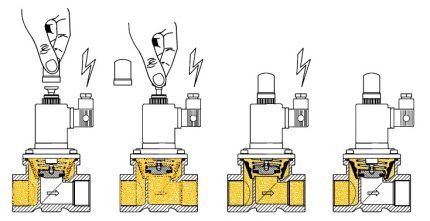
Cutters with electrical impulse control are available on sale. They work differently. In the open position, the valve is held in place by a latch. If the coil receives a current pulse from the sensor, the latch is released.
If the closing pulse arrives during a power outage (e/e) and when the alarm is triggered, the device acts as normally closed. If the pulse comes only from the sensor signal, the valve operates on the normally open principle and does not interrupt the gas supply when the electricity is turned off. These algorithms can be changed using the alarm settings.
We have provided more information about the types of solenoid valve and the principle of operation of the device in our other article.
Correlation of cutter parameters with the system
When choosing a device, the diameter of the pipe at the valve insertion site matters. In most cases, a device with a Dn value of 15, 20 or 25 is suitable for domestic needs, which corresponds to 1/2″, 3/4″ and 1″ pipes.
If the system has boiler or columnthat do not operate when the power supply is turned off, a normally open valve is installed.
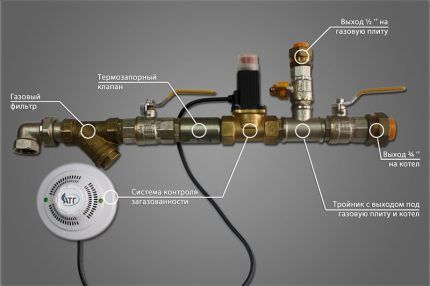
If the operation of the devices does not depend on the power supply, a normally closed shut-off switch is installed. It will not block the equipment in the absence of electricity and will not leave the room unprotected.
Installing the device on a pipe
Work on introducing a shut-off valve into the system is carried out only by a master - a gas service employee or an individual entrepreneur. It is mandatory that he has a special permit to perform this type of work and permits.
When choosing a location for installation, it is necessary to take into account ease of access to manual cocking.
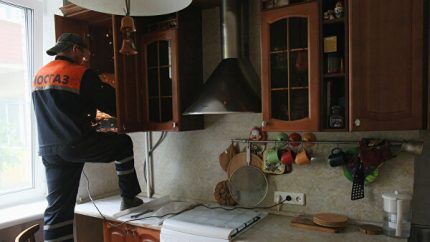
Where installation is possible:
- before gas meter, if its design does not provide for the use of a cut-off switch at the input to disconnect it;
- in front of a household gas appliance - stove, water heater, boiler;
- at the main entrance into the room, if it has a gas meter with a disconnecting device at a distance of at least 10 m from the entry point.
To ensure that the valve is installed quickly and efficiently, you should call the technicians in advance and find out if additional consumables will be needed. If yes, it is advisable to buy them in advance. The space where the work will be carried out must be cleared, and kitchen surfaces and appliances must be covered with tarpaulin, burlap or other materials that are not prone to combustion.
When performing installation, specialists must strictly adhere to the requirements of standards and regulatory documents. It is also recommended to follow the manufacturer's data sheets and instructions for the devices.
Device Maintenance
Self-service involves removing dust from the device. If a breakdown is detected, you need to call an employee gas company.
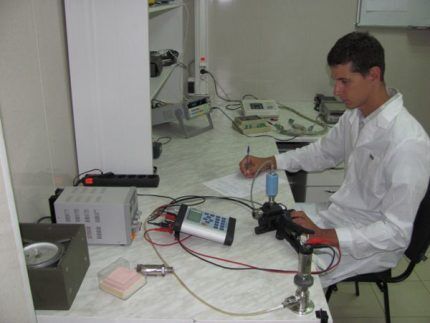
It is prohibited to carry out maintenance of the devices yourself. Intentional supply of a non-special gas mixture can lead to damage to the sensitive elements of the device.
Design efficiency
Installing an alarm and gas valve in an apartment does not guarantee 100% protection against leaks or unauthorized interference in the operation of devices. The system, depending on the installation location, turns off only a separate section of the gas pipeline or device.
But a leak is also possible on a common house line, so stopping the supply of fuel to one device cannot be called effective. False confidence in complete safety can provoke much more negative consequences. We recommend that you look at information about how gas explodes in an apartment.
It is only truly effective to equip all apartments and premises in the building with a monitoring system. In this case, if there is a gas leak, the supply will stop throughout the entire pipeline.
Conclusions and useful video on the topic
Review of a household alarm with a valve, system assembly.
Analysis of the design of the sensor and valve, its parameters, demonstration of the operation of the device.
Most fires in apartments occur due to gas leaks. Installing a sensor with a valve will help prevent serious consequences from such situations. But the safety of property and human lives is guaranteed only when the equipment is correctly selected and its installation is carried out by a qualified gas service worker.
Do you have a gas sensor installed in your apartment complete with a valve on the gas pipe and would you like to tell us how this equipment protected your family and property from the negative consequences of a gas leak? Share your experience, leave recommendations on the advisability of installing such locking devices - the comment form is located below the article.



